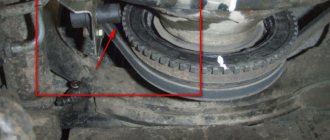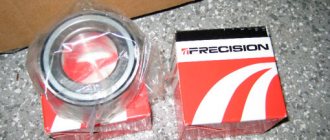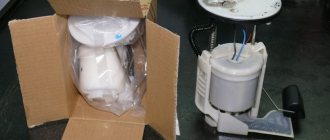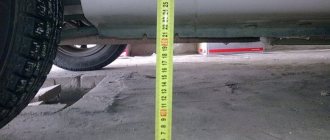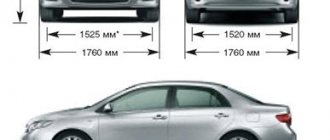When a Toyota Corolla car has problems with the heating system, it does not turn on, most often the failed parts have to be replaced with new ones. The relatively weak point of the heater of this car is the radiator, resistor or rheostat of the Toyota heater and thermostat. Although sometimes other heater elements need to be replaced.
In search of a solution to the problem of poor heating by the Toyota Corolla stove
If the heater in your car stops working normally, then as winter approaches, the need to solve this problem is growing every day. The heater on a Toyota Corolla does not blow well for several reasons, each of which should be considered separately. The fact that cold or barely warm air begins to blow from the stove, although the switch is turned on for heating, does not surprise anyone. This is a fairly common Corolla problem. But it can be solved with your own hands.
Possible causes of poor heating
When the heater on a Toyota Corolla 120 does not heat well, you need to consider two main potential causes.
- poor circulation of coolant, which is located in the heater radiator;
- weak air flow generated by the stove fan.
Important ! If the stove does not work at all, then try checking the condition of the relays and fuses in the mounting block. Often the reason turns out to be trivial and easily eliminated.
When the problem is not in the relay or fuses, you have two options - contact a car service center, where they will charge you who knows how much and for what, or take on the Toyota Corolla yourself. This will take more time, but will save money and provide invaluable experience in car repair and maintenance.
Let's look at the potential causes and troubleshooting steps separately.
Poor coolant circulation in the radiator
Your stove blows cold air or slightly warm air if the circulation of coolant inside the heating radiator is disrupted.
In this situation you need:
- Check the coolant level by looking into the expansion tank. If there is little cooling liquid, there may not be enough for the stove to operate efficiently. The problem is simple, but relevant among young drivers and owners of the 120 Toyota Corolla. So start by checking the basic reasons. Add the required amount of coolant and check if the heater has resumed operation.
- The seal on the radiator cap is broken. Not a rare occurrence. Normally, the pressure inside the system on a Toyota Corolla is slightly more than 1 kilogram. This can be determined by the degree of elasticity of the hoses when the engine is warm. The pressure rises after the thermostat is activated.
- The operation of the stove tap is broken. The heater tap on the Toyota Corolla operates from an electric motor from inside the car using traction. This rod looks like a rigid steel wire, which is fixed to the flag of the stove faucet. If it is jammed or does not move well, it is better to replace the element immediately.
- Failure of the pump or thermostat. If the thermostat is faulty, it simply does not work when the engine warms up and the heater does not work. Problems with the pump or pump prevent the coolant from being pumped properly.
- Contamination in the stove and radiator. It is recommended to periodically flush the system. Washing is done in different ways. But it is best to remove the coolant supply and return hoses, insert temporary hoses in their place, connect the compressor and pump some kind of cleaner through the system. Craftsmen from among the people use hydrogen peroxide, drain cleaning fluids, and even yogurt. Before doing this, you need to drain all the coolant from the system, pump it with a cleaning agent, and then simply blow air through the compressor. Fill the coolant back in and start the engine to get rid of excess air in the system. This is what a typical DIY heater flush looks like.
- The dampers do not work or function poorly. Here you can’t do without a visual check. You will have to disassemble the structure and see how tightly the dampers are pressed, open and react to changes in the position of the regulator. They can be sealed, adjusted, or simply replaced with new ones if there is a mechanical failure of the dampers.
Weak air flow from the heater
Here the reasons may be as follows:
- the heater radiator is clogged (cleaning, washing or blowing with compressed air can remove all the dirt);
- the inlet air filter is clogged (if your Toyota Corolla has one);
- stove mode switches do not work;
- The electric motor of the stove has failed.
If the reason lies in the stove itself and its components, you will have to disassemble the device, replace parts or immediately install a new unit.
Important !
Dismantling work is carried out only with the negative terminal removed from the battery and with at least minimal experience. You risk breaking plastic parts, so try to be careful.
Dismantling and replacement of parts
- To remove the heater, you will need to unscrew several fasteners in the front passenger's foot area. The Toyota Corolla heater motor is located there.
- Remove the clamps and unscrew the fastening screws. Now the hatch can be opened by prying it up with a flat screwdriver. Nothing complicated here.
- The electric motor must be removed from the heater housing. To do this, the housing itself and the fan (impeller) should be warmed up with a regular hairdryer. This will make it easier to remove. A hair dryer is better suited, as it can heat up to 200 degrees. A household hair dryer will work, but will take longer.
- Enlist the help of a partner. One will heat, and the second will gently push the electric motor out of the plastic case. Be extremely careful not to break the case.
- Having disassembled the heater, you can change its parts, check the operation and at the same time treat the elements with lubricant, rinse and blow everything properly.
- Before reassembling, we recommend checking the operation of the motor. To do this, connect any DC source to it. If it rotates without noise or obstruction, then reassemble the assembly in reverse order.
The design and operation of the components of the Toyota Corolla does not cause any particular complaints. Time passes, and therefore even the most reliable cars can develop certain problems. Eliminating them is not that difficult. But if you lack experience or skills, it is better to contact a good service.
Leave comments and write how the heater works on your Corolla, what you had to do with it. We will definitely discuss these issues, try to answer questions and give practical advice.
Run
The Toyota Corolla 150's suspension is well balanced for comfort and handling. Its components stubbornly oppose the bad Russian roads. The stabilizer bushes spoil the picture after covering approximately 30,000 km. In the future, it is recommended to change them to extended ones with a longer service life. The plastic front mounts were weak. It starts knocking after 30-40 thousand km. Further measures have been taken, support material has been improved and the number of complaints has been reduced.
READ KIA RIO 3 heater does not heat well
The steering was also not up to par. After 30-40 thousand km, both the steering shaft and the steering rack were replaced. Sign. Knocks and rollbacks in case of uneven movement.
The stove fan does not work.
- Author
- Message
The stove fan does not work.
Posted by johannvoler » Sun Jan 10, 2021 9:58 am
Hello friends! Happy holidays to everyone!
I've got a little problem!
The stove has stopped working! At first it turned on from time to time, but yesterday it stopped!
I checked the motor - ok, it works! I checked all the fuses on the left - ok, the rest of the fuses are also normal. The relay clicks when turned on.
I checked the voltage on the chip when turning it on - it’s normal. (12 V in all modes) The resistance is normal.
And this is where the fun began:
When I connect the chip to the motor, the voltage disappears. I almost sat down)) where can it go?
I turn off the chip - there is voltage!
Guys, I hope you can help! Thank you!
Re: Heater fan not working.
Post by Vaso » Sun Jan 10, 2021 10:31 am
johannvoler wrote: Hello friends! Happy holidays to everyone!
I've got a little problem!
The stove has stopped working! At first it turned on from time to time, but yesterday it stopped!
I checked the motor - ok, it works! I checked all the fuses on the left - ok, the rest of the fuses are also normal. The relay clicks when turned on.
I checked the voltage on the chip when turning it on - it’s normal. (12 V in all modes) The resistance is normal.
And this is where the fun began:
When I connect the chip to the motor, the voltage disappears. I almost sat down)) where can it go?
I turn off the chip - there is voltage!
Guys, I hope you can help! Thank you!
Re: Heater fan not working.
Posted by johannvoler » Sun Jan 10, 2021 10:47 am
What fuse are we talking about?
About Square 40 A or about regular 15A?
Re: Heater fan not working.
Post by Vaso » Sun Jan 10, 2021 10:56 am
johannvoler wrote: Thanks, I'll try.
What fuse are we talking about?
About Square 40 A or about regular 15A?
Re: Heater fan not working.
Posted by johannvoler » Sun Jan 10, 2021 11:39 am
Re: Heater fan not working.
Post by antik » Sun Jan 10, 2021 12:24 pm
Re: Heater fan not working.
Posted by johannvoler » Sun Jan 10, 2021 3:10 pm
Re: Heater fan not working.
Post by mihman25 » Sun Jan 10, 2021 3:16 pm
Re: Heater fan not working.
Post by Vaso » Sun Jan 10, 2021 3:56 pm
Re: Heater fan not working.
Posted by johannvoler » Mon Jan 11, 2021 9:30 am
How does the stove work?
In cars with body numbers E120 and E150 2012 and some other years of production, the heater is designed almost identically, so maintenance and care do not make any fundamental difference.
If the stove fan whistles, the heating system itself has stopped working, the air has stopped circulating properly, or, conversely, the device heats up when it is not required, it is worth checking the stove radiator.
For example, let's look at how the heater works on a 2003 Toyota Corolla E12. This model is quite old, so the arrangement of its elements is simple. It is worth noting that cars in the 100 and 110 bodies have the same heater design. Problems appear over time, most often these are the following problems:
- The heater fan does not work on the Toyota.
- In general, the stove does not work.
- Air enters only from one side.
- There is a coolant leak.
- The stove does not heat well, or not all of its modes work.
- The radiator supplies moist air.
- The motor has failed.
- An unpleasant odor appeared.
- The heater cannot turn on.
Engines
The car received two 1.4-liter (4ZZ-FE) and 1.6-liter (1ZR-FE) engines. The first was inherited from the previous model. The 1.6 engine was developed from scratch. The 1.4 was later replaced by 1.33 liters. The 1.6 and 1.33 engines are equipped with the DUAL VVT-i system, which provides good performance and fuel economy. All Toyota engines have a reliable timing drive.
Features of the 1.6 engine. The presence of an extraneous knock until it warms up. As the temperature rises, detonation decreases, merging with the general noise of the heated engine. This knock is barely audible and if you are not listening it is almost inaudible.
With a mileage of more than 40-50 thousand km, the water pump often gets stuck. A sign will be increased noise from the drive and the appearance of traces of a coolant leak on the pulley or dried splashes on the engine compartment.
The engines are very economical; even when driving fast, high gas costs are not required.
How to repair?
Only by disassembling the device can you determine exactly why it does not work. Before removing the radiator, check that the relay is working properly; The fuse is less likely to blow. If this is the cause, cleaning or repair may not be necessary.
For ease of work, it is advisable to remove all foreign objects from the interior. In order to remove the heater on the King, you will need to remove the dashboard, otherwise you will not be able to get the heater core. You need to start removing the center panel from the driver's side. Please note that for the 100th body this place is on the right side. The nuts are usually stuck and need to be treated with WD-40.
It is impossible to get to the stove fan without removing the drive rod. It is necessary to remove the rod from under the fixing brackets, disconnect all the cables, and turn off the crane control lever.
The design of the heater fan switch in Toyota Corolla 2008, 2012 is simple, but putting the device back together is quite difficult. It is recommended to take photographs of everything during disassembly.
In addition to the cable, all levers must be removed, otherwise they will interfere with disassembling the structure. A screwdriver will be useful for removing the spring latch, after which you can remove the radiator casing and pull the heater out of the casing. Once you can disassemble it, you can make the necessary repairs and flush the system. Quite often, the heating device does not heat up well or may stop blowing due to the fact that it is clogged with dirt.
Less commonly, the radiator may need to be replaced. By removing it, you can repair the heater valve or replace it. Check the location of the pipes, replace old ones with new ones, as cracks may be observed. If the radiator is in good condition, it can be reinstalled. Next you need to check the motor. This part is quite vulnerable and can fail more often than others. The electric motor is fixed using a special plate, which is easy to remove - just pry it off with a screwdriver. Remove the impeller from the motor shaft; You will also have to remove the spring clips as they hold the engine in place.
It is better to immediately replace the additional resistor. The stove motor can be reached through a special hole in the stove casing.
The easiest way is to replace the entire engine.
It's hard to find parts for it, even if you have a 2012 car, let alone an older E12.
see also
Comments 21
MB, who will need this information? On the nze124 fielder, when I was changing the fan, I noticed that for the 3 bolts holding it in, you need either a star screwdriver or a flat one, there is a braid going under it that does not allow it to be removed, do not try to rip it off, there is a clip on the side, You squeeze it on both sides and it comes off easily. And so, a huge thank you to the author for the post, thanks to him, at -20 I didn’t freeze too much)) And yes, my cover in the passenger’s feet does not come off completely, but bends down, is held on by 2 clips, unfortunately they did not survive, I had to take a couple of new ones
How is the car warm in cold weather or not? My 4zz runs fine, but it cools down on the spot, and it’s not yet -25, but only -15.
Dude, I sold the car about 3 years ago))) I definitely didn’t freeze in it
So we will bet 1zz.
Well, how lucky you are! But along the way, I’ll have to take it from analysis...
The brushes are easy to change, the main thing is to choose the size 8*8
The impeller is removed. I was just doing this today, I disassembled exactly the same fan, only not Bosh of course, but it looks like yours in the photo. In general, to remove the impeller you need to remove the locking clip, then slightly bend the plastic separate tooth in front of the shaft knob, and spend a long time tediously prying it from below (I did this with a knife), but here they do it with scissors -
. After removing the impeller, there is a whole epic of removing the engine itself from the plastic housing, but the whole joke is that I still didn’t get to the bearings themselves, because it’s not clear how to disassemble them further. Unlike the author of the video, I also removed the foam gasket above the upper bearing and coated everything generously with Lithol as best I could. Then I sprayed 5 ml of Dexron 3 into the gaps between the shaft and the gaskets. There was 3 times more kaki than yours, plus there were branches! And some kind of plant seeds! Since there is no cabin filter in Surf, a lot of this crap gets stuffed in there. But in the end I did not eliminate the cause; the fan blows very powerfully, but the sound does not go away. It’s as if something is touching something somewhere, although I looked through everything and there are no mechanical impediments to torsion anywhere. In short, I wasted half a day in vain. We'll have to take it apart...
Conclusion
The operation of a car heater can last quite a long time. But over time, some parts fail, which makes it difficult to turn on the heater motor and warm up the interior. Any Toyota car owner of 2003, 2008, 2012 and other cars can independently replace faulty components, spending a little time on it. If you still have questions about heating repair, there are many videos on the Internet that will help solve this technical problem in different types of models: Toyota station wagon, Ranx, Corolla Spasio, cars E120, E150, E12, 2012 and other years of production.
The heater fan stopped working at 1-2-3 speeds
The stove fan suddenly stopped working at 1-2-3 speeds. Only works in full HI mode. In climate control mode (AUTO), the fan begins to rotate at maximum speed only when temperature limits are set (in the cold or red zones) and operates only at maximum speed. What could be wrong? Who has any guesses? We have winter in Surgut until June, I use the stove almost all year round. My guess: either a relay or a thyristor control unit. But how can you quickly find them where they are installed and check their functionality? Does anyone have photos and have encountered a similar problem?
There are 9 replies to this topic
You need to look for the correct assumptions by looking at the wires coming from the fan motor.
I have the same thing. It’s a glitch in the control unit. It can be repaired, but the repair lasted for two weeks. I bought a new one - 2000 rubles.
homega I have the same problem, please tell me how you fixed it
Most likely you need to change the part, Called: RESISTOR, BLOWER catalog number: 87138-12140 on the existential (power resistor of the stove fan). Quite often they had to be changed on different machines.
Have you figured out the problem? I have the same problem, I would like to know the solution
It's a resistor issue. The current is not suppressed by the resistor and goes to the maximum to the fan; low speeds do not work. The resistor is of variable value and its resistance is changed manually by rotating the LO-M1-M2-HI regulator. In the HI position, current flows bypassing the resistor. The problem is not the relay or wiring, otherwise the fan wouldn't work at all.
The text of the message was changed by the user on March 12, 2021 at 13:08:12
It looks like this:
In our region, a new one costs approximately 1200-1500 rubles; you can find it at a disassembly site for 500 rubles.
Replacing the resistor is not a complete solution to the problem. A burnt out resistor is a consequence, not a cause. It burns out due to the increased current passing through it. Options for what to check in case of a relapse: 1. The motor shaft is spinning tightly - check, lubricate, replace if everything is bad. 2. Short circuit in the motor armature. It is difficult to identify and treat; it is easier to change the motor. 3. Increased resistance to air movement after the fan. The heater or air conditioner evaporator radiator is clogged. A clogged cabin filter, if any, or a blocked air flow, on the contrary, reduces the motor current, which is why the filter is placed before the motor. 4. Alternatively, increased voltage in the on-board network.
Alternatively, the temperature fuse has blown (2A 114c). The price of the issue is 40 rubles to be located near the transistor. But when replacing, you must immediately remove the stove motor and check its condition, the cleanliness of the air cooling channels, etc.
The text of the message was changed by the user on June 28, 2021 at 00:28:13
online now
- Mikeken
based on activity data for the last 5 minutes.
Transfer method
Massive complaints from breeders did not go unnoticed, and a search for the problem began. At first they tried to solve the problem by replacing the clutch and disengaging the clutch with a better one, but the problems continued. Then Toyota engineers began to look for the reason in electronics and algorithms. As a result, the transmission control units were replaced with warranty machines. First up to version 291 instead of 290, and then up to 292. The computer itself is located behind the glove compartment. The block number, or rather its three digits, is the firmware version. After replacing the unit and installing the clutch, the manufacturer announced a resource of at least 100,000 km. In fact, it barely exceeds 50-60 thousand km. If the problematic items have not yet been replaced, this could result in a tidy sum for the new owner. In 2009, they refused to install robotic boxes at all. Instead, they started installing the old, reliable, time-tested 4-speed automatic transmission. No complaints yet.
In addition to automatic transmissions, the Corolla was also equipped with a 5-speed and later 6-speed manual transmission. They haven't received any specific complaints. The clutch disc lasts more than 60,000 km. Among the shortcomings, some owners complained about the creaking of the clutch pedal and the gear shift lever. It can be removed by lubricating problem areas with WD-40 or similar products.
The appearance of twitching when releasing the clutch pedal with a simultaneous increase in the throttle in 1st and 2nd gears, and sometimes when reversing. A sign that the clutch pedal needs to be adjusted.
Some Toyota Corolla owners note an increase in noise when driving in first and reverse gears. In fact, this is not a defect, but only a feature of working in these modes.
